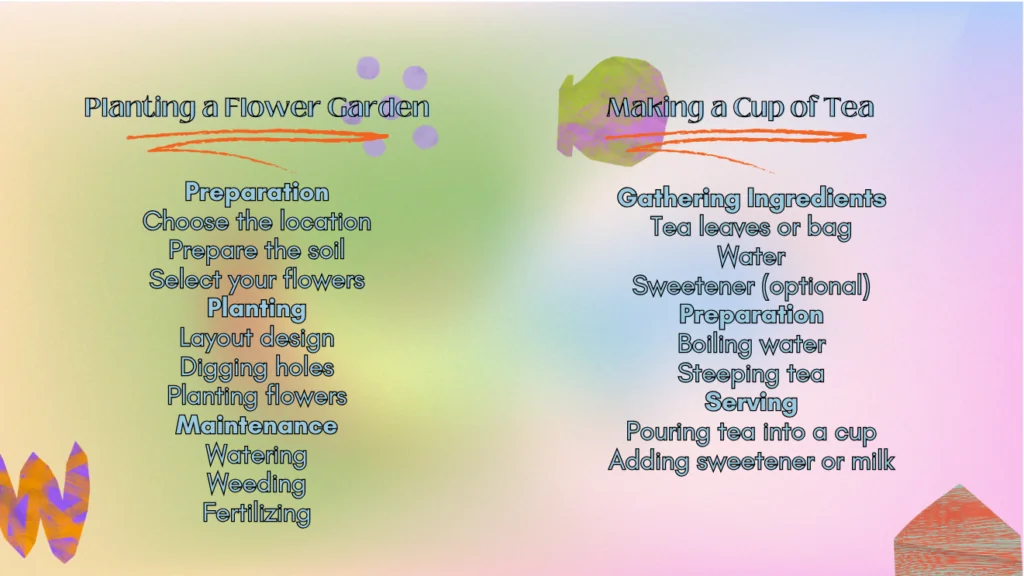A process paper is a type of writing that explains how to do something or how something works. It’s really helpful both in school and in the workplace. In uni, you might be asked to write a process paper to describe a scientific experiment or to explain how a historical event unfolded.

✅ AI Essay Writer ✅ AI Detector ✅ Plagchecker ✅ Paraphraser
✅ Summarizer ✅ Citation Generator
Structured writing, which you use in a process paper, involves organizing your thoughts in a clear, logical order. This makes your writing easier to follow and more effective. Whether you’re explaining how to bake a cake or detailing a lab procedure, the structure helps your reader follow each step without getting lost. Think of it as giving your readers a map that guides them through your words; each point leads smoothly to the next, making the whole process easier to understand. Let’s learn how to create a process paper properly!
What Is a Process Paper
A process paper is a type of writing that details a method or explains how something works. It guides the reader through the steps required to complete a task or understand an operation. This makes them extremely helpful in both educational and professional settings.
| Type | Description |
|---|---|
| How-to Guides | Provides clear, step-by-step instructions on how to perform tasks or activities, like recipes or DIY projects. |
| Explanation Papers | Explains the workings of something in detail, such as a scientific process or mechanical operation. |
Writing a process paper involves not just listing steps but also connecting with the reader to make the process approachable and understandable. When writing such a paper, it’s important to keep your audience in mind, use clear and concise language, and include all necessary details without overwhelming the reader. This approach helps make sure that anyone following your paper can successfully complete the task at hand, whether they’re setting up a science experiment, starting a new job, or trying out a hobby.
Why Is Research Necessary for Process Papers?
Research is absolutely necessary for writing process papers because it is key to the accuracy and reliability of the information presented. For example, if you are explaining how to perform a scientific experiment, you need detailed, well-researched steps so that others can replicate the results successfully. Research involves gathering information from credible sources, understanding the procedure thoroughly, and sometimes even testing the process yourself to verify each step.
Imagine you’re tasked with writing a process paper on preparing a garden for planting. You’ll need to research the types of soil, garden layouts, seedling care, and more. This could involve consulting gardening books, speaking with experts, or reviewing gardening websites. Each detail must be carefully researched to provide readers with a clear, actionable guide that leads to successful outcomes.
Thorough research teaches students the importance of backing their instructions with factual data, which not only improves their learning experience but also forces a habit of thorough investigation. This preparation is important because it builds the foundation of a reliable and effective process paper that others can confidently follow. But enough with the boring stuff; now we will talk about creating an outline for such paper.
Creating an Outline for Your Process Paper
Creating an effective outline for your process paper is like mapping out a path. With a good outline, every step is clearly marked and easy to follow. Here’s a simple guide on how to create a structured outline that will make writing your process paper much smoother.
Step 1: List All Steps. Start by jotting down every action or part of the process you want to explain. Don’t worry about the order just yet; the aim is to make sure you don’t forget any critical parts of the process.
Begin your process paper by setting the stage. Introduce the process you’ll be explaining and provide a bit of background. It’s helpful to explain why this process is useful or necessary. Highlight the significance of the process to give readers insight into what they can gain or learn from understanding and following these steps.
Step 2: Organize Steps in a Logical Sequence. Once you have all the steps written down, start placing them in the order they need to be performed. Some steps will naturally fall into place because you can’t do one without completing another first.
Step 3: Detail Each Step Under Main Headings and Subheadings. Now, expand each step into more detailed instructions. Use main headings for each major step and subheadings for detailing the specifics of each step. This will not only help in keeping your writing organized but also make it easier for readers to follow.
Here are two examples for very simple processes such as planting a garden and making tea.

What About Main Body or Conclusion?
The body of your process paper should break down the process into clear, manageable steps. It’s important to describe each step in enough detail to make sure that your readers can follow along without confusion. As you move from one step to the next, use clear transitions to maintain a logical flow. This keeps the reader engaged, and also helps them see the connection between each part of the process.
Wrap up your process paper by summarizing the steps you’ve covered. This reinforces the process in the reader’s mind. Highlight why the process is beneficial and discuss what the reader can expect to achieve by following it accurately. This part of your conclusion should prove the importance of the process and suggest potential outcomes or final products that result from following the process correctly.
Process Paper Writing Tips for Students
When you’re writing a process paper, the key is to keep it as simple and straightforward as possible. You want everyone, no matter their background or how much they already know about the topic, to be able to follow along easily. Here’s how you can make your process paper clearer and more accessible:
 Use Simple Language
Use Simple Language
Try to write as if you’re explaining the process to a friend who has never heard of it before. Avoid using too much technical jargon or overly complex terms. If you must use specific terms, make sure to explain them well. This approach helps so that everyone can understand your steps without getting bogged down by confusion.
 Incorporate Visual Aids
Incorporate Visual Aids
Think about adding pictures, diagrams, or charts to your paper. Visuals can be a huge help in breaking down more complex steps or showing parts that are hard to describe with words alone. For example:
- Diagrams can show how parts connect or fit together, which is especially handy for things like assembly instructions.
- Charts are great for processes that involve numbers or comparisons.
- Photos or screenshots can guide readers through physical or digital tasks.
 Clarify Each Step
Clarify Each Step
Make sure each step in your process is explained clearly. Don’t just say what to do, but why it’s done that way. If there are different ways to do something, or if something might not always work the same way, explain those variations. Giving a bit of extra context can help prevent frustration and mistakes.
 Provide Examples
Provide Examples
Adding a couple of examples can really help to ground your instructions in reality. Show how the process works in real life or what the end result should look like. Examples can also highlight common pitfalls and how to avoid them.
 Feedback Loops
Feedback Loops
It’s smart to suggest that readers check their progress at certain points in the process. This is like saying, “Now, stop and check what you’ve done before moving on.” It’s a great way to catch mistakes early and make sure everything is going as planned.
FAQ
Follow us on Reddit for more insights and updates.





Comments (0)
Welcome to A*Help comments!
We’re all about debate and discussion at A*Help.
We value the diverse opinions of users, so you may find points of view that you don’t agree with. And that’s cool. However, there are certain things we’re not OK with: attempts to manipulate our data in any way, for example, or the posting of discriminative, offensive, hateful, or disparaging material.